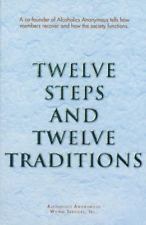
"Anonymity is the spiritual foundation of all our traditions, ever reminding us to place principles before personalities."

 |
Tradition Twelve "Anonymity is the spiritual foundation of all our traditions, ever reminding us to place principles before personalities." |
 |
"THE spiritual substance of anonymity is sacrifice. Be- cause A.A.’s Twelve Traditions repeatedly ask us to give up personal desires for the common good, we realize that the sacrificial spirit—well symbolized by anonymity—is the foundation of them all. It is A.A.’s proved willingness to make these sacrifices that gives people their high confi- dence in our future. (Page 184)From this, we see that Tradition Twelve is more than practical advice on the conduct of individuals and groups in A.A. Just as the practice of Step Twelve embodies all the earlier Steps, the principle behind this Tradition underlies all those that came before. The idea of self-sacrifice is also explicitly mentioned in Tradition One (Page 130), and is strongly implied in Tradition Five (Page 150). Like Twelve, these Traditions inform all the others.
The author then begins a lengthy digression on the history of anonymity in A.A., showing the anvils of experience on which this and Tradition Eleven were hammered. Early groups were secret societies, and new members could only find them and join through friends. "The bare hint of publicity, even for our work, shocked us. Though ex-drinkers, we still thought we had to hide from public distrust and contempt." (Page 184) This concern was a partial motivation for the idea of personal anonymity in the original Foreword to the Big Book.
Later, when there were more groups, it became somewhat common for people to talk about recovery, sometimes including other people's stories. When such stories were circulated, the loss of confidence in A.A.'s anonymity promise caused some to turn away. Confidentiality regarding people's stories as well as their names had to be maintained. "This was our first lesson in the practical application of anonymity." (Page 185) This concern for members' intimate details was dates back to the time of the Big Book, and is mentioned there on Page 125 (The Family Afterward).
However, some newcomers, bright-eyed and exuberant about their newfound sobriety, were eager to talk about their own recoveries. Others went public with their stories. Sometimes these people got drunk, letting down their groups and becoming A.A. show-offs instead of A.A. members. "Our growth made it plain that we couldn’t be a secret society, but it was equally plain that we couldn’t be a vaudeville circuit, either. The charting of a safe path between these extremes took a long time." (Page 185) Dr. Bob is quoted as having this thought on anonymity in different circumstances: "The A.A. who hides his identity from his fellow A.A. by using only a given name violates the Tradition just as much as the A.A. who permits his name to appear in the press in connection with matters pertaining to A.A." (Dr. Bob and the Good Old Timers, Page 264)
The newcomer wants to tell his family, doctor, and friends right away about is new way of life. With more confidence, he tells his employer and business associates. This recalls the process outlined in Step Nine, in which we approach others affected by our drinking. The newcomer might later share his experience when he sees opportunities to be helpful to others. This Twelfth Step practice, in turn, helps him get over fear of the alcoholic stigma. Word of A.A. in the community is spread by such means. "Though not in the strict letter of anonymity, such communications were well within its spirit." (Page 186) But this word-of-mouth method was too limited to reach all those desperate for help. Groups began to hold meetings open to the public, for friends and interested people so they could learn more about A.A. These open meetings are mentioned in the Big Book. (Working With Others, Page 159-160) A.A. members even began to speak to civic and church groups, among other venues. This is appropriate, so long as anonymity is maintained.
In the first few years after the Big Book was published, the fellowship began to attract major publicity in the mainstream press, culminating in the widely-read article 1941 Jack Alexander article in the Saturday Evening Post. With public demand soaring for stories on recoveries, the temptation for potential promoters within the fellowship was greatly increased. Seeing the danger in this situation, the Founders came to a conclusion: "At this altitude (press, radio, films, and television), anonymity—100 percent anonymity—was the only possible answer. Here, principles would have to come before personalities, without exception." (Page 187)
Directly addressing the Tradition again, the author recalls the inspirational tone and hint of a changed outlook found near the end of Step Twelve (Page 124-125) in which he describes life after having had a Spiritual Awakening:
These experiences taught us that anonymity is real hu- mility at work. It is an all-pervading spiritual quality which today keynotes A.A. life everywhere. Moved by the spirit of anonymity, we try to give up our natural desires for personal distinction as A.A. members both among fellow alcoholics and before the general public. As we lay aside these very human aspirations, we believe that each of us takes part in the weaving of a protective mantle which covers our whole Society and under which we may grow and work in unity. We are sure that humility, expressed by anonymity, is the greatest safeguard that Alcoholics Anonymous can ever have. (Page 187)